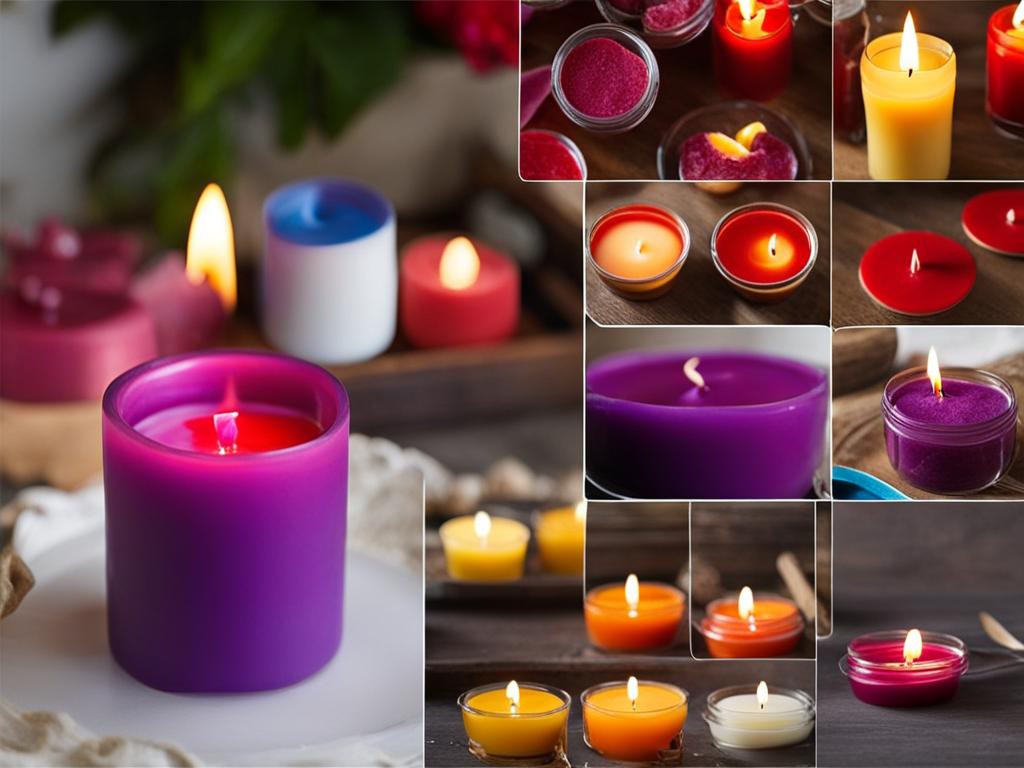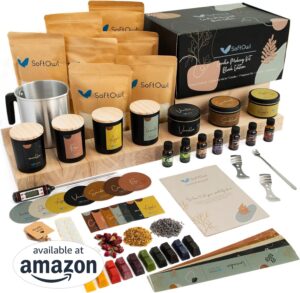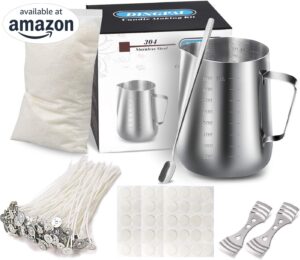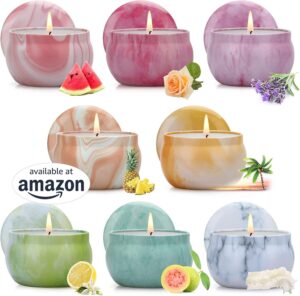If you’ve ever wanted to learn how to make your own candles, you’re in luck! In this step-by-step guide, I will walk you through the entire candle making process, from gathering your supplies to lighting your finished creation. With this tutorial, you’ll be able to create beautiful homemade candles that are perfect for decorating your home or giving as personalized gifts.
Whether you’re a DIY enthusiast or simply looking for a new and creative hobby, candle making is a wonderful skill to learn. Not only does it provide a sense of accomplishment, but it also allows you to customize your candles to match your personal style and fragrance preferences.
This candle making tutorial will cover everything you need to know, including choosing the right wax, adding scents and fragrances, the cost comparison between homemade candles and store-bought ones, tips for selling your homemade candles, and the essential supplies for candle making.
If you’re ready to embark on a crafty journey and create your own candles, let’s get started with this detailed step-by-step guide to DIY candle making!
Choosing the Right Wax for Your Homemade Candles
When it comes to candle making, the choice of wax plays a crucial role in determining the quality and characteristics of your homemade candles. With a range of options available, it’s important to understand the unique properties of each type of wax. Whether you’re a beginner or an experienced candle maker, selecting the right wax is essential for achieving the desired results.
Let’s explore some popular choices:
Soy Wax:
Soy wax, derived from soybean oil, is a natural and renewable resource. It is known for its clean-burning properties and slow, even melt. Soy wax is an excellent choice for beginners due to its ease of use and ability to hold fragrance oils well. It also has a longer burn time compared to other waxes, making it a cost-effective option in the long run.
Paraffin Wax:
Paraffin wax is a widely used and affordable option for candle making. It has excellent fragrance-holding capacity, which means your homemade candles will emit a strong and long-lasting scent. With paraffin wax, it’s easy to achieve vibrant colors and smooth finishes. However, it’s important to note that paraffin wax is derived from petroleum and may not be as eco-friendly as other wax options.
Beeswax:
Beeswax is a natural and sustainable wax option that is obtained from bees’ honeycombs. It has a pleasant, honey-like aroma and a distinctive golden color. Beeswax candles are known for their clean-burning properties and long burn time. However, beeswax may not hold fragrance oils as well as other waxes, so it’s best suited for those who prefer a subtle, natural scent.
Coconut Wax:
Coconut wax, made from the refined oil of coconuts, is a vegan and sustainable choice for candle making. It has a creamy and smooth texture, and its natural blend of coconut and soy wax offers excellent fragrance throw. While coconut wax is pricier compared to other options, its eco-friendly characteristics and luxurious finish make it a popular choice among candle enthusiasts.
When choosing the wax for your homemade candles, consider your preferences, sustainability goals, and the specific qualities you want in your final product. Experimenting with different waxes can help you discover your signature candle-making style and create unique, personalized candles that delight the senses.
Next Steps: Candle Scenting and Fragrance
Once you’ve chosen the right wax, the next step in the candle making process is adding scent. In the next section, we’ll explore different options for scenting your homemade candles, including fragrance oils and essential oils. Stay tuned to create candles that not only look beautiful but also fill your space with delightful aromas.
Adding Scent to Your Homemade Candles
Adding scent to your homemade candles is a crucial step in creating a personalized and aromatic experience. Whether you want to create a calming ambiance with lavender, a refreshing scent with lemon, or a cozy atmosphere with cinnamon, fragrance oils and essential oils are the key ingredients to achieve the perfect scent for your homemade candles.
When it comes to choosing fragrance oils, there are countless options available. From fruity and floral scents to warm and woody notes, you can find a wide variety to suit your preferences. Alternatively, essential oils offer a natural and therapeutic fragrance for your candles. Popular choices include lavender, eucalyptus, and peppermint.
Experimentation is key when it comes to creating unique fragrance blends. Combine different scents to find the perfect combination that resonates with you. Whether you prefer a single oil or a blend of multiple oils, be sure to follow the recommended ratio of one ounce of oil per pound of wax to achieve the desired scent intensity.
“Experiment with different combinations to create your own unique fragrance blend.”
Remember that the quality of your fragrance oils and essential oils can greatly impact the final scent of your candles. Opt for high-quality oils from trusted suppliers to ensure a long-lasting and pleasant fragrance.
Adding scent to your homemade candles not only enhances the ambiance but also allows you to create a personalized experience for yourself and your loved ones. Whether you gift them or keep them for yourself, scented candles can create a warm and inviting atmosphere in any space.
The Cost of Homemade Candles vs. Store-Bought
Making your own candles can be a cost-effective alternative to buying store-bought candles. While high-end candles can cost $30 or more, the cost of making homemade candles can be significantly lower.
By purchasing wax in bulk and using synthetic scents, you can save money on materials. For example, a 45-pound bag of soy wax beads costs about the same as a single high-end candle.
With some planning and budget-conscious choices, you can enjoy the satisfaction of creating your own candles at a fraction of the cost.
Creating your own candles not only allows you to express your creativity but also saves you money. Store-bought candles can add up, especially if you enjoy using them frequently or want to have candles in multiple rooms of your house.
By investing in some basic candle-making supplies and following a few simple tips, you can make beautiful candles that rival those sold in stores.
First and foremost, gather all the necessary materials to ensure a smooth candle making process. You’ll need wax, wicks, fragrance oils, containers, a double boiler or similar melting pot, a thermometer, and a spatula for stirring the wax.
Choose the type of wax that suits your preferences and goals. Soy wax is a popular option for beginners as it is natural and slow-burning. Paraffin wax is affordable and holds fragrance well. Beeswax is environmentally friendly, though it may not hold fragrance oils as strongly. Coconut wax is vegan and sustainable but can be pricier.
Once you have all your supplies, you can start creating your candles. Follow a step-by-step guide, such as the one provided in this article, to ensure you don’t miss any crucial steps along the way.
In addition to cost savings, making your own candles allows you to customize the scents and styles to your liking. Experiment with different fragrance oils and essential oils to create unique blends that fill your space with delightful aromas.
Take advantage of various containers and molds to create candles in different shapes and sizes. Personalize your candles with decorations like dried flowers or ribbon bows to make them extra special.
Not only will you enjoy the process of making homemade candles, but you’ll also have the satisfaction of knowing you can recreate your favorite scents whenever you want without breaking the bank.
Tips for Selling Homemade Candles
If you’re interested in turning your passion for candle making into a business, there are a few tips to keep in mind. Competition in the candle industry is fierce, but by offering unique scents that reflect the season or location where you’re selling, you can stand out from the crowd.
As I discovered in my journey of selling homemade candles, creating unique candle blends is essential for attracting customers. Experiment with different fragrance combinations to develop signature scents that people will love and remember. Consider combining unexpected scents like lavender and vanilla or citrus and sandalwood to create intriguing aromas.
Another way to make your homemade candles stand out is by exploring different candle shapes and decorations. Get creative and use molds to shape candles into unique designs like flowers, geometric shapes, or even animals. Twisted taper candles and layered pillar candles can also add visual interest to your product lineup.
Decorating candles with added embellishments can be another selling point. Consider customizing pillar candles with pressed flowers, dried herbs, or twine bows. These small decorative touches can transform ordinary candles into stunning, one-of-a-kind pieces that customers won’t be able to resist.
Remember, finding your niche in the candle market is crucial. Research your target audience and identify what sets your candles apart from others. Whether it’s using all-natural ingredients, promoting sustainability, or supporting a specific cause, find your unique selling point and make it a central focus of your business.
By following these tips and incorporating your creativity, you can carve out a successful place in the competitive candle industry. With each homemade candle you sell, you’ll be sharing your passion and artistic expression with others while building a thriving business.
Supplies for Candle Making
To make homemade candles, you will need a few essential supplies. These include wax, wicks, fragrance oils, containers, a double boiler or a similar melting pot, a thermometer, and a spatula for stirring the wax. The type of wax you choose will depend on your preference and candle-making goals. Be sure to have enough wicks for each candle, and consider using wick stickers or hot glue to secure them to the bottom of the containers. Take your time to gather your supplies before starting the candle-making process.
Before you can dive into the creative process of making homemade candles, it’s important to have all the necessary supplies on hand. Let’s take a closer look at each item and its significance in creating beautiful candles.
Wax
The main ingredient for candles is wax. You have a variety of options to choose from, such as soy wax, paraffin wax, beeswax, or coconut wax. Each type of wax has its unique properties, so consider the desired outcome of your candles when making your selection.
Wicks
Wicks are responsible for carrying the flame and providing a steady burn. Make sure you have enough wicks for each candle and choose the appropriate size depending on the container and the desired burning time.
Fragrance Oils
Fragrance oils add delightful scents to your candles. Explore a wide range of options such as lavender, vanilla, or citrus to create a unique and inviting ambiance.
Containers
Containers hold the wax and act as a decorative element. You can use glass jars, ceramic containers, or even repurpose old candle containers to create your personalized candles.
Double Boiler
A double boiler or a pot with a heat-safe bowl on top is essential for melting the wax. This method helps maintain a consistent temperature, preventing the wax from burning or overheating.
Thermometer
Using a thermometer ensures that the wax is heated to the correct temperature, as different types of wax have different melting points. This allows for safe and optimal candle making.
Spatula
A spatula is used to stir and mix the melted wax and fragrance oils evenly. This ensures that the fragrance is distributed throughout the candle, providing a delightful scent.
By having these supplies ready, you’re well-prepared to embark on your candle making journey. The right combination of wax, wicks, fragrance oils, containers, a double boiler, a thermometer, and a spatula will help you create beautiful and aromatic homemade candles.
Step-by-Step Candle Making Process
Now that you have all your supplies ready, let’s get started with the candle making process. Follow these step-by-step instructions to create beautiful homemade candles:
1. Prep Containers: Ensure your containers are clean and dry. Place them on a flat surface, ready to be filled with melted wax.
2. Melt Wax: Measure the desired amount of wax and melt it using a double boiler or a similar melting pot. Stir occasionally with a spatula until the wax is completely melted and smooth.
3. Add Fragrance: Once the wax is melted, add your preferred fragrance oils or essential oils. Stir gently to distribute the scent evenly throughout the wax. Remember to follow the recommended ratio for the desired scent intensity.
4. Place Wick: Take your pre-cut wicks and place them in the center of each container. You can use wick stickers or a small amount of hot glue to secure the wick to the bottom of the container.
5. Pour Wax: Carefully pour the melted wax into each container, ensuring a steady and even stream. Leave about half an inch of space from the top to allow room for the candle to burn properly.
6. Clean Up: Clean up any wax spills or drips using a paper towel or a cloth. It’s important to remove any excess wax before it hardens.
7. Cure Candle: Allow the candles to cool and harden completely. This process, known as curing, usually takes a few hours or overnight. Avoid touching or moving the candles during this time to ensure a smooth and even finish.
8. Light Candle: Once the candles are fully cured, trim the wick to about a quarter-inch in length. Light the wick and enjoy the warm and cozy ambiance of your homemade candles.
By following this candle making tutorial, you will be able to create your own customized candles for personal use or as heartfelt gifts. Let your creativity shine through and experiment with different fragrances, containers, and decorations to make each candle unique.
Disclaimer: Some links in this blog post may be affiliate links. If you purchase through these links, we may earn a small commission at no additional cost to you.





